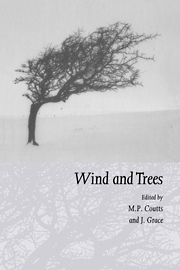Book contents
- Frontmatter
- Contents
- Preface
- List of contributors
- Part I Airflow over topography and in forests
- Part II Mechanics of trees under wind loading
- Part III Tree physiological responses
- Part IV Impacts of wind on forests and ecology
- Part V Risk assessment and management response
- 21 Assessing the risk of wind damage to forests: practice and pitfalls
- 22 Forest wind damage risk assessment for environmental impact studies
- 23 Recommendations for stabilisation of Norway spruce stands based on ecological surveys
- 24 Thinning regime in stands of Norway spruce subjected to snow and wind damage
- 25 A synopsis of windthrow in British Columbia: occurrence, implications, assessement and management
- 26 Wind damage to New Zealand State plantation forests
- 27 The experience of and management strategy adopted by the Selwyn Plantation Board, New Zealand
- Index
24 - Thinning regime in stands of Norway spruce subjected to snow and wind damage
Published online by Cambridge University Press: 27 October 2009
- Frontmatter
- Contents
- Preface
- List of contributors
- Part I Airflow over topography and in forests
- Part II Mechanics of trees under wind loading
- Part III Tree physiological responses
- Part IV Impacts of wind on forests and ecology
- Part V Risk assessment and management response
- 21 Assessing the risk of wind damage to forests: practice and pitfalls
- 22 Forest wind damage risk assessment for environmental impact studies
- 23 Recommendations for stabilisation of Norway spruce stands based on ecological surveys
- 24 Thinning regime in stands of Norway spruce subjected to snow and wind damage
- 25 A synopsis of windthrow in British Columbia: occurrence, implications, assessement and management
- 26 Wind damage to New Zealand State plantation forests
- 27 The experience of and management strategy adopted by the Selwyn Plantation Board, New Zealand
- Index
Summary
Abstract
Between 1981 and 1990 more than 50% of the total timber yield in the Czech Republic had to be cut down due to some kind of injury, mostly windthrow or snowbreak. Most damage occurred in stands of spruce (Picea abies Karst.), a species occupying 55% of the forest area. Snow is the main damage factor in younger stands, in the period of height growth culmination. The best protective measure, proven by many experiments, is stimulation of diameter growth by wide spacing or heavy thinning in the period of canopy closure. On the other hand, wind damage starts when the top height of the stands exceeds 10–15 m, and the most reliable protection is a closed canopy and mutual shelter of individuals, with resistance to snow damage created by the previous treatment at a younger stage. A thinning regime is proposed for spruce stands suffering from both snow and wind. Heavy thinning in young stands is recommended, changing to light thinning and growth with full canopy closure in the second half of the rotation. This thinning regime is supported by the results of three long-term experiments in north-eastern Bohemia.
Introduction
Damage to forests by abiotic factors (snow, ice and especially wind) is a very frequent phenomenon in countries where forestry has been based on artificial regeneration with one prevailing species and where the relevant weather conditions are severe. This situation can be found in all Middle European countries (Germany, Switzerland, Austria, Slovakia, the Czech Republic and Poland) as well as in Great Britain and elsewhere (Australia, New Zealand and Japan).
- Type
- Chapter
- Information
- Wind and Trees , pp. 436 - 447Publisher: Cambridge University PressPrint publication year: 1995
- 17
- Cited by



